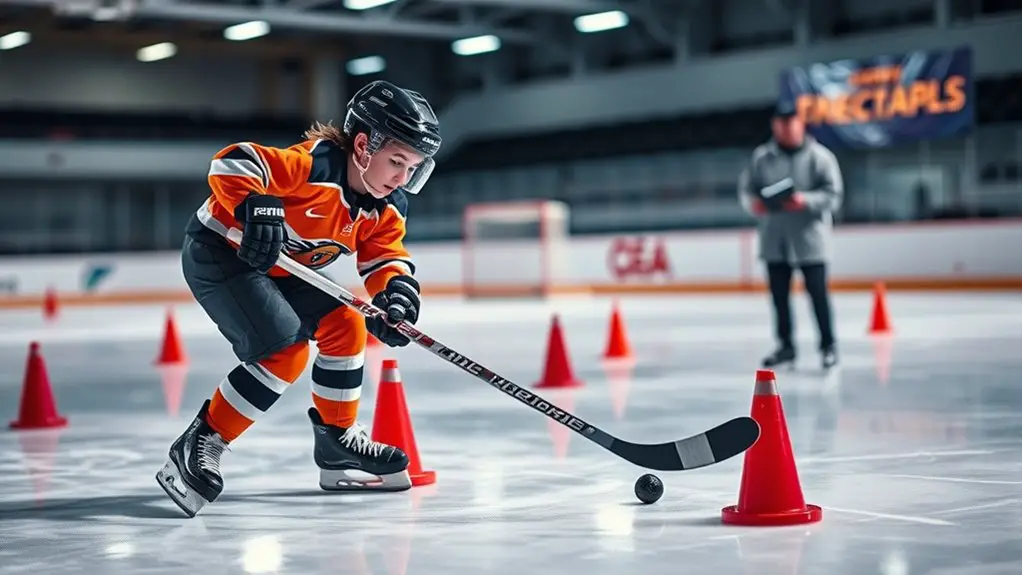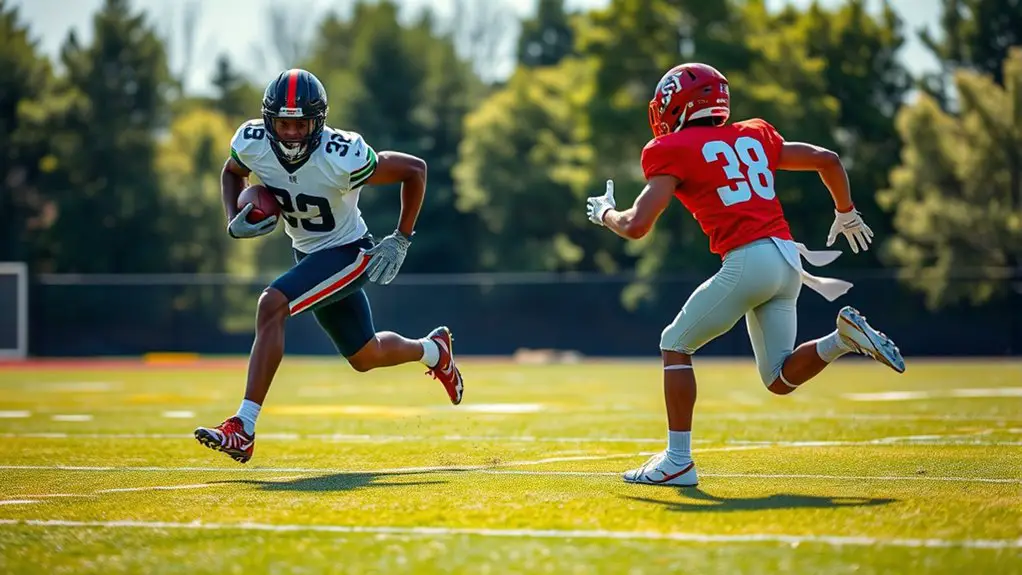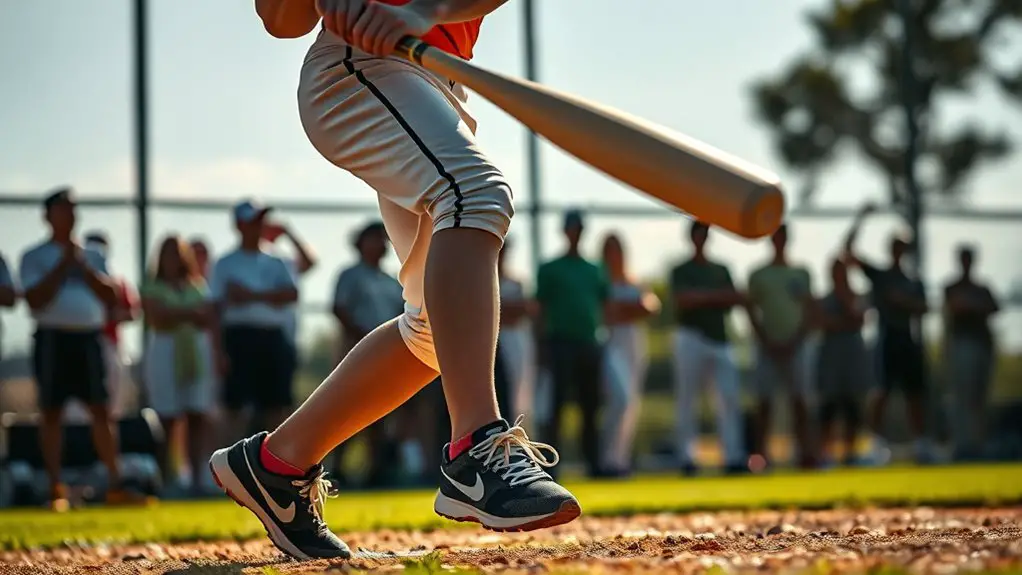To improve your stickhandling, start with basic drills like stationary puck control and figure-eight weaving. As you progress, add advanced techniques such as T-Push drills and quick movements around obstacles. Incorporating game-like scenarios with cones will boost your agility and decision-making. Don't forget to practice one-handed stickhandling, as it'll enhance your overall control. Keeping sessions fun and consistent will lead to better skills. Stick around to discover even more effective drills to elevate your game!
The Importance of Stickhandling in Hockey
While many aspects of hockey require teamwork and strategy, stickhandling often stands out as a fundamental skill that can make or break a player's performance. Mastering stickhandling gives you the freedom to navigate through defenders, maintain possession, and create scoring opportunities. The stickhandling benefits extend beyond just puck control; it enhances your overall game awareness and confidence on the ice.
As you focus on skill development, you'll find that improved stickhandling opens up a world of possibilities. You'll learn to read the game better, anticipate opponents' moves, and execute plays with precision. This skill not only empowers you to break free from tight situations but also enables you to contribute to your team's success. So, embrace the challenge of stickhandling, and you'll see how it elevates your game to new heights, giving you the freedom to express your style on the ice.
Basic Stickhandling Drills for Beginners
Starting with a few simple stickhandling drills can make a big difference in your hockey skills. As a beginner, focusing on basic techniques will help you develop foundational skills that'll set you up for success on the ice.
One effective drill is the stationary puck control. Place the puck in front of you and practice moving it side-to-side with gentle taps. This'll improve your touch and control. Another great exercise is the figure-eight drill. Set up two cones or any markers, and weave the puck around them in a figure-eight pattern. This'll enhance your agility and hand-eye coordination.
Lastly, try the one-handed stickhandling drill. Hold your stick with one hand while maneuvering the puck around obstacles to build strength and confidence. By incorporating these beginner techniques into your routine, you'll find yourself becoming a more skilled and versatile player in no time! Furthermore, developing agility through drills can significantly enhance your overall performance on the ice.
Advanced Stickhandling Techniques
Now that you've mastered the basics, it's time to elevate your game with advanced stickhandling techniques. You'll want to focus on puck control drills and quick movements to outsmart defenders. These skills will not only enhance your agility on the ice but also improve your overall gameplay.
Puck Control Drills
Mastering advanced puck control is essential for any hockey player looking to elevate their game. To truly release your potential, focus on effective puck control techniques that will help you maneuver through tight spaces and evade defenders. Start with the "T-Push" drill, where you use your stick to push the puck in a "T" shape while maintaining a low stance. This enhances your ability to control the puck while in motion. Another fantastic drill is the "Figure Eight," which reinforces stickhandling strategies by forcing you to navigate the puck around obstacles. Incorporate these drills into your routine, and you'll notice a significant improvement in your ability to maintain possession and make those slick plays that leave opponents guessing.
Quick Movements Practice
Building on your puck control skills, quick movements are essential for effective stickhandling in fast-paced game situations. To elevate your game, focus on drills that enhance your quick footwork and improve your reaction timing. Start by setting up obstacles, like cones, to navigate through using rapid, controlled strides. As you weave in and out, keep the puck close and practice changing direction swiftly. Incorporate sudden stops and starts to mimic game scenarios. Pair this with partner drills, where you respond to unpredictable puck movements, sharpening your ability to react swiftly. Remember, the more you practice these quick movements, the more freedom you'll feel on the ice, allowing you to outmaneuver opponents with confidence and skill.
Puck Control Exercises With Cones
When it comes to enhancing puck control, using cones for drills can be incredibly effective. Cone drills create a dynamic environment that challenges your puck handling skills while allowing you to express your creativity on the ice. Set up a series of cones in various formations and practice weaving in and out, focusing on maintaining control of the puck at all times.
One great exercise is the zigzag drill, where you maneuver the puck through cones spaced evenly apart. This not only improves your agility but also helps you develop quick hands and sharp turns. You can also try tight turns around cones to simulate game-like scenarios, giving you the freedom to explore different angles and movements.
Don't forget to mix in speed and slow down when needed. These puck control exercises with cones will elevate your game, making you more confident and unpredictable on the ice. Enjoy the freedom to play!
One-Handed Stickhandling Drills
Although it may seem challenging at first, incorporating one-handed stickhandling drills into your practice routine can greatly enhance your control and dexterity on the ice. These one-handed exercises help you develop your ability to maneuver the puck with just one hand, allowing for quick adjustments during a game. Start with basic stickhandling techniques, like pushing the puck back and forth with one hand, then progress to more complex movements such as figure eights or weaving through obstacles.
Practicing these drills not only builds strength in your wrist and forearm but also improves your overall puck handling skills. Consider using a stationary object to challenge yourself further, like a cone or a stick, to navigate around while maintaining control. As you grow more comfortable, you'll find freedom in your movements, making you a more dynamic player on the ice. Embrace these one-handed drills, and watch your game elevate!
Stickhandling With Speed and Agility
To excel in hockey, mastering stickhandling with speed and agility is essential, as it allows you to navigate through defenders and create scoring opportunities. Incorporating speed drills and agility exercises into your training will elevate your game and give you the edge you need on the ice. Consistency in practice is crucial for improving overall agility and enhancing your performance on the ice.
Here are some drills to help you develop these skills:
- Cone Weaving: Set up cones and maneuver through them at high speed, focusing on quick stick movements.
- Puck Control Sprints: Combine sprints with puck handling to simulate real-game scenarios.
- Lateral Movements: Practice shifting side to side while handling the puck to improve your agility.
- Obstacle Course: Create a course with various obstacles to enhance your reaction time and speed.
Creative Stickhandling Drills for Game Situations
When it comes to game situations, your stickhandling needs to shine under pressure. You'll want to focus on drills that enhance your puck control and quick decision-making skills. Practicing in game-like scenarios can really help you adapt and perform when it counts.
Puck Control Under Pressure
Mastering puck control under pressure is essential for any hockey player looking to excel in game situations. When you're facing aggressive defenders, maintaining puck possession while executing smooth defensive maneuvers can set you apart. Here are some drills to help you thrive under pressure:
- Obstacle Course: Navigate through cones while protecting the puck.
- 1-on-1 Battles: Practice keeping the puck away from a defender in tight spaces.
- Mirror Drill: Pair up and mimic each other's movements while handling the puck.
- Pressure Situations: Simulate game scenarios with defenders closing in, focusing on quick puck movement.
Quick Decision-Making Drills
After honing your puck control under pressure, the next step is enhancing your quick decision-making skills. Think of decision-making scenarios as your chance to release creativity on the ice. Set up drills where you've got to react swiftly to changing conditions—like a defender closing in or a teammate breaking open. Try cognitive stickhandling exercises that involve rapid puck movement while anticipating your next move. Create a small space with cones and practice weaving through them while deciding whether to pass, shoot, or deke. These drills will sharpen your instincts, allowing you to make split-second choices. With each practice, you'll feel more confident and free to express your style, making you a dynamic player in any game situation.
Game-Like Scenario Practices
To truly elevate your game, incorporating game-like scenario practices into your stickhandling drills is essential. These drills help improve your situational awareness and mimic real-game pressure, allowing you to react instinctively. Here are a few creative drills to contemplate:
- Obstacle Course: Set up cones to navigate while stickhandling, simulating defenders.
- Two-on-One Situations: Practice against two defenders, enhancing decision-making under pressure.
- Breakout Drills: Work on moving from defense to offense, focusing on quick puck movement.
- Game Simulation: Use small-sided games to replicate game scenarios, fostering teamwork and tactical skills.
Tips for Practicing Stickhandling Effectively
While stickhandling might seem straightforward, practicing effectively requires focus and strategy. To get the most out of your time on the ice, break down your sessions into specific stickhandling techniques. Start slow, mastering the fundamentals before increasing speed and complexity. This way, you'll build a solid foundation.
Incorporating game-like scenarios can enhance your effective practice. Set up obstacles and time limits to simulate real-game pressure. Challenge yourself by alternating between hands and using various pucks, like weighted ones, to improve strength and control.
Don't forget to keep it fun! Experiment with different drills and invite friends to join in for some competitive edge, which can boost your motivation. Regularly assess your progress and tweak your practice based on what you discover. Remember, consistency is key—stick with it, and you'll notice improvement in no time. Enjoy the freedom that comes with mastering your stickhandling!
Frequently Asked Questions
How Can I Improve My Stickhandling Without a Puck?
You might think stickhandling without a puck isn't effective, but it can actually boost your hand-eye coordination and muscle memory greatly. Try using a tennis ball or simply your hands to mimic the movements. Focus on quick, precise movements while keeping your eyes up, imagining the puck's path. This'll help you feel more fluid and in control. You'll be surprised how much it translates to real gameplay!
What Equipment Is Best for Stickhandling Practice?
When you're looking to enhance your stickhandling, the right equipment can make a big difference. Stickhandling tools like weighted pucks or training balls can help develop your skills effectively. Pair these with practice surfaces like slick tiles or smooth wood, and you'll create an ideal environment for improvement. Investing in these essentials gives you the freedom to practice anywhere, anytime, ensuring you're always honing your technique and staying sharp on your game.
How Often Should I Practice Stickhandling Drills?
You should aim to incorporate stickhandling drills into your daily routine for maximum improvement. Practicing at least three to four times a week can really boost your skills, but it's all about what feels right for you. If you can squeeze in some extra sessions on days you're feeling motivated, go for it! The key is finding a practice frequency that keeps you engaged without feeling like a chore. Enjoy the process!
Can Stickhandling Be Practiced off the Ice?
Absolutely, you can practice stickhandling off the ice! Off-ice techniques, like using a stickhandling ball or a smooth surface, can really help. These exercises allow for skill transfer, meaning the skills you develop off the ice can directly improve your game when you're back on the rink. So, grab your stick and ball, and enjoy the freedom of practicing wherever you like—it's a great way to enhance your skills anytime!
What Are Common Mistakes in Stickhandling to Avoid?
Oh, you think you can just wave your stick around and call it stickhandling? Think again! Avoid common mistakes like neglecting stickhandling fundamentals, which can lead to disastrous puck control. Remember, it's not just about speed; finesse matters too. Don't forget to keep your head up and your body relaxed. Embrace the art of movement, and you'll find that freedom on the ice—while avoiding the cringe of being that guy who can't handle the puck!




